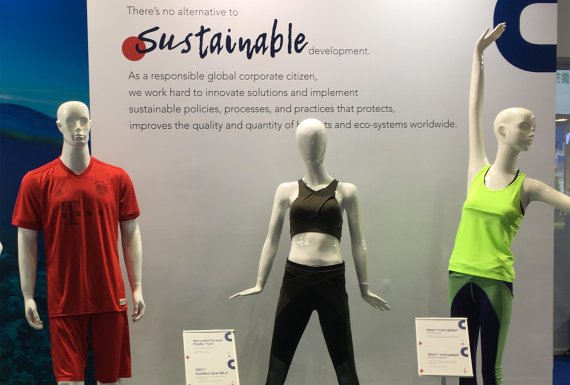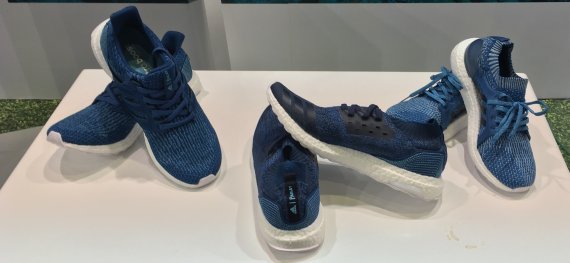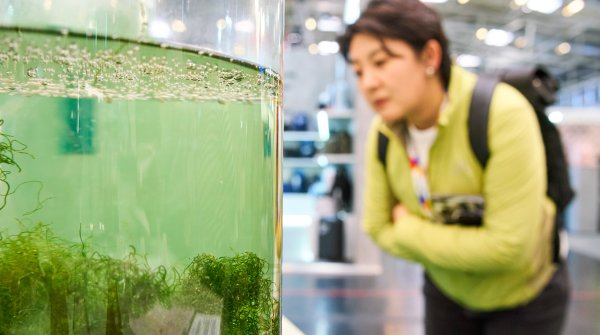
It's on everyone's mind and part of a progressive movement, not just in the textile apparel industry but pan-industrial, as sustainable solutions become a dead cert than just a thought. One company in particular is changing its ways across the board, fully vertical textile company Far Eastern New Century. Being fully vertical, the company has complete control throughout the textile chain from chips and fiber to fabrics, finishing and garment production.
It’s the extensive R&D and the speed the company can move at that results in sustainable products reaching the market efficiently, including TopDry, non-woven PFC-free DWR (durable water resistant) polymer that featured in ISPO TEXTRENDS for Fall/Winter 18/19. Unlike the traditional DWR treatments which are finishing agents, the polyester innately has the DWR performance delivered at the chip level, which can then be extruded into filament yarns or films.
This innovation means that DWR can be applied to fleece fabrics without affecting the hand, even footwear, especially with the different flat knit technology. One single tiny change at the polymeric level has a whole range of uses.
There is no stopping this company as can be seen from the latest developments revealed to ISPO.com by Jeffrey Hsu, manager of the R&D Centre.
With the message clear, sustainability is the way forward, but collaboration is also a feature, we are all in it together. One of the most talked of collaborations is that between FENC and Parley, the NGO that collects plastic waste from the ocean that can be seen in the Adidas Parley sports shoes.
FENC delivers the technology and converts the waste into yarns. The collection of waste is undertaken in the Maldives with FENC advising Parley how to get to scale. “At first they were shipping 500 kilos in a container ship, through sharing our expertise then can now ship 25 tonnes in a ship,” explained Hsu. Advice from FENC included the wrapping and compressing the waste. The waste is then shipped to Taiwan to FENC’s recycling plant, where they cut plastic waste through to extruding the yarn.

When recycled polyester first entered the market, the appealing story of recycled plastic bottles that we all responsibly dispose of being converted into yarn that would then be used in apparel was widely accepted. For the consumer, the sense of involvement about doing something towards the environment was real. In turn, within the textile industry, once this development had been launched, as with bamboo when that entered the market, many textile companies claimed to carry this new recycled wonder yarn.
But the volume didn’t tally with the amount of bottles it was possible to recycle. The problem with recycled polyester, as with organic cotton and other recycled fibers, it is impossible to tell the difference between the recycled product and the conventional equivalent.
FENC has overcome this problem by introducing a traceable element to both recycled polyester from plastic retrieved from the ocean to terrestrial plastic bottles. The latest innovation is a tracer - a unique ID that the company has just started incorporating into its recycling system.
“We have two exclusive lines of tracer ID one for ocean recycled plastic and one for our own recycled polyester from plastic bottle. The ID ingredient is put into the polymer at the extrusion stage of the recycled polyester and traceability can be confirmed by a third party lab,” explained Hsu.
“If you are a brand house and have specified to your textile manufacturer to use Far Eastern recycled yarn, both post consumer and ocean waste, it can be verified by an independent testing facility to confirm the origin by identifying the ID tags. Traceability is very strong right now, we have been doing it since 1998. There’s stills a level of knowledge that needs to be gained: the how do I know this is the true product.”
One area that recycled goods has is the weakness any recycled product can have against the conventional/virgin product. This has happened in the textile chain. This comes about as the product is in its pure state, but when recycled it can weaken the product physically, resulting in a sub standard sustainable solution. Hsu agreed, but confirmed that FENC has overcome this problem.
“We can say with a high degree of confidence in every sense of definition our recycled polyester is on par with virgin. In the past there were problems with lower tenacity and yellowing, but not now,” he said, adding that plastic waste from the ocean from Parlay does have a blueish tone, something that Adidas likes as a water look tone to its footwear.
Once upon a time the textile chain worked in a vertical direction. Fibers and yarns first, then to fabrics and finishing though to merchandisers from brands sourcing the textiles to deliver the apparel to the consumer. Today it is a different story, as branding doesn’t just feature at retail, but also is developing at the fiber and yarn stage.
Latest developments in branded yarns include recycled cotton Ecotec to Seaqual, the latest ocean plastic recycled yarn. Established yarn brands including Repreve, the recycled polyester from post consumer plastic developed by Unifi to Cordura and Sensil to name a few.
Yarn brands are big business, with many companies placing their marketing at a B2C communication level, in order for a much more aware market of what is available to them on the retail floor. “Previously brand houses only worked with mills, but with more and more of the technical development coming from the yarn supplier, the brand houses are now proposing the yarns that the textile manufacturers need to use,” said Hsu, adding the importance of traceable IDs in confirming the textile manufacturers are sourcing as requested.
There is no stopping FENC in continuing on its sustainable path as water free dyeing features and the launch of the latest innovation: the world’s first post consumer water breathable membrane is about to become commercial. “We launched with a footwear version, we don’t supply the fabric but we share our expertise in how to laminate the membrane. Vaude are launching this for Spring 19,” he said.
The speed at which the FENC is developing can be laid firmly in its foundation as a fully vertical company combined with the key three factors outlined by Hsu: Integration , Sustainability and Innovation.
If you consider garment designs can take three to six months to develop, textile development one to three years. Yarns and filaments two to five years and a new polymer can take approximately ten years to develop, the length of time that traditional textile development takes adds up.
“We have everything, no JDMs (joint development manufacture), JVs (joint ventures) we also have the advantage of speed, the R&D centre has 200 members. We have engineers with a accumulation of 100 years experience. We have a unique capacity to do things in a way, not to sound boastful, that no one else in the world can do” he said.
As for the most requested performances, according to Hsu it used to be thermal regulation, now the buyers ask is diverging towards sustainable solutions and functions.
- ISPO awards
- Mountain sports
- Bike
- Design
- Retail
- Fitness
- Health
- ISPO Job Market
- ISPO Munich
- ISPO Shanghai
- Running
- Brands
- Sustainability
- Olympia
- OutDoor
- Promotion
- Sports Business
- ISPO Textrends
- Triathlon
- Water sports
- Winter sports
- eSports
- SportsTech
- OutDoor by ISPO
- Heroes
- Transformation
- Sport Fashion
- Urban Culture
- Challenges of a CEO
- Trade fairs
- Sports
- Find the Balance
- Product reviews
- Newsletter Exclusive Area
- Magazine






